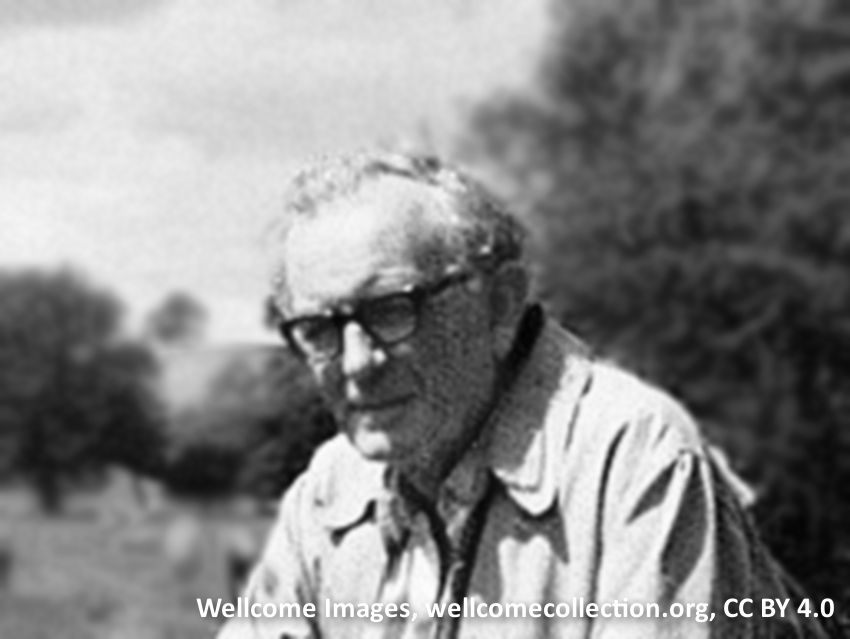George Porter was born on December 6, 1920, in Stainforth, UK. He was the co-creator of flash photolysis and received the Nobel Prize in Chemistry in 1967 together with Manfred Eigen and Ronald George Wreyford Norrish “for their studies of extremely fast chemical reactions, effected by disturbing the equilibrium by means of very short pulses of energy.”
Porter and Norrish developed flash photolysis after World War II to study fast chemical reactions [1–3]. In this method, a short, intense light pulse (the “pump pulse”) is used to induce a chemical reaction, and further short light pulses (“probe pulses”) are used to monitor the reaction and observe the resulting intermediates. It was originally developed to study free radicals in the gas phase. Today, it is used, e.g., to study photosynthesis or different light-induced reactions. Flash photolysis can also be used as a relaxation method to study the kinetics of fast reactions by rapidly disturbing a chemical equilibrium with the pump pulse and then observing the return to equilibrium, or “relaxation”, of the system.
George Porter studied chemistry at the University of Leeds, UK, where he received a Bachelor’s degree in 1941. During World War II, he served in the Royal Naval Volunteer Reserve. After the war, he joined the University of Cambridge, UK, where he worked with Norrish. Porter received his Ph.D. from Cambridge in 1949 for work on “free radicals produced by photochemical means.” From 1953 to 1954, he was Assistant Director of the British Rayon Research Association, which studied the chemical and physical properties of rayon and similar fabrics.
Porter then became Professor of Chemistry at the University of Sheffield, UK, where he served from 1954 to 1965. In 1966, he became Fullerian Professor of Chemistry and Director of the Royal Institution, London, UK. In 1985, he became President of The Royal Society, resigned his full-time post as Director of the Royal Institution, and moved to Imperial College, London, UK, to continue his research. Besides his work on fast chemical reactions, Porter is also well-known for his advocacy in the public understanding of science. He championed fundamental research and advocated for broad science education in schools.
In addition to the Nobel Prize and many other honors, Porter received the Davy Medal in 1971, the Rumford Medal in 1978, the Ellison-Cliffe Medal in 1991, and the Copley Medal in 1992, as well as several honorary degrees and doctorates. He was knighted by Queen Elizabeth II in 1972, appointed to the Order of Merit in 1989, and was made a life peer as Baron Porter of Luddenham in 1990. He was a Member of the U.S. National Academy of Sciences, the American Academy of Arts and Sciences, the German Academy of Sciences Leopoldina, the Russian Academy of Sciences, the Hungarian Academy of Sciences, and a Fellow of the Royal Society, UK. In 2001, the University of Leicester’s chemistry building was named the “George Porter Building” in his honor. Lord Porter died on August 31, 2002.
George Porter is the answer to Guess the Chemist (108).
References
- [1] The structure of methylene,
Ronald George Wreyford Norrish, George Porter,
Disc. Faraday Soc. 1947, 2, 97–104.
https://doi.org/10.1039/df9470200097 - [2] Chemical Reactions Produced by Very High Light Intensities,
Ronald George Wreyford Norrish, George Porter,
Nature 1949, 164, 658.
https://doi.org/10.1038/164658a0 - [3] Flash photolysis and spectroscopy. A new method for the study of free radical reactions,
George Porter,
Proc. R. Soc. A 1950, 200, 284–300.
https://doi.org/10.1098/rspa.1950.0018
Sources
- George Porter KT OM, Lord Porter of Luddenham: 6 December 1920 – 31 August 2002,
Graham R. Fleming, David Phillips,
Biogr. Mem. Fellows R. Soc. 2004, 50, 257–283.
https://doi.org/10.1098/rsbm.2004.0017 - Obituary: George Porter (1920 – 2002),
David Phillips,
Nature 2002, 419, 578.
https://doi.org/10.1038/419578a
Selected Publications
- Triplet States in Solution,
George Porter, Maurice W. Windsor,
J. Chem. Phys. 1953, 21, 2088–2088.
https://doi.org/10.1063/1.1698772 - Primary photochemical processes in aromatic molecules. Part 3. Absorption spectra of benzyl, anilino, phenoxy and related free radicals,
George Porter, Franklin J. Wright,
Trans. Faraday Soc. 1955, 51, 1469.
https://doi.org/10.1039/TF9555101469 - Primary photochemical processes in aromatic molecules. Part 2. Observations on the triplet state in aromatic vapours,
George Porter, Franklin J. Wright,
Trans. Faraday Soc. 1955, 51, 1205–1211.
https://doi.org/10.1039/TF9555101205 - Observation of Short-lived Free Radicals in Solution,
George Porter, M. W. Windsor,
Nature 1957, 180, 187–188.
https://doi.org/10.1038/180187a0 - Giant‐Pulse‐Laser Flash Photolysis of Phthalocyanine Vapor,
G. Porter, J. I. Steinfeld,
J. Chem. Phys 1966, 45, 3456–3457.
https://doi.org/10.1063/1.1728134 - Nanosecond flash photolysis,
George Porter, M. R. Topp,
Proc. R. Soc. A 1970, 315, 163–184.
https://doi.org/10.1098/rspa.1970.0035 - Forty years of photochemistry,
George Porter,
J. Chem. Soc., Faraday Trans. II 1986, 82, 2445.
https://doi.org/10.1039/F29868202445


